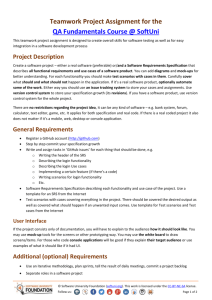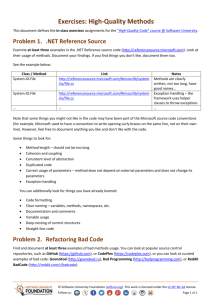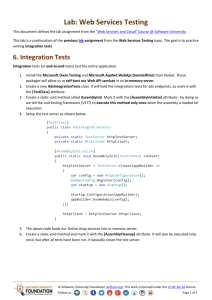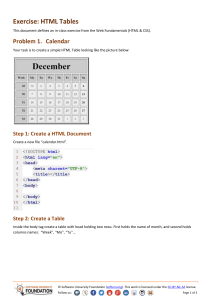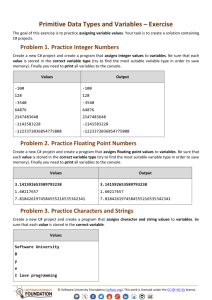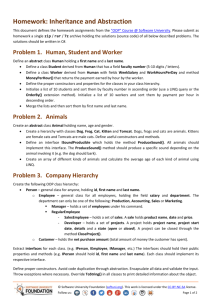High-Quality Code - Teamwork Assignment
advertisement
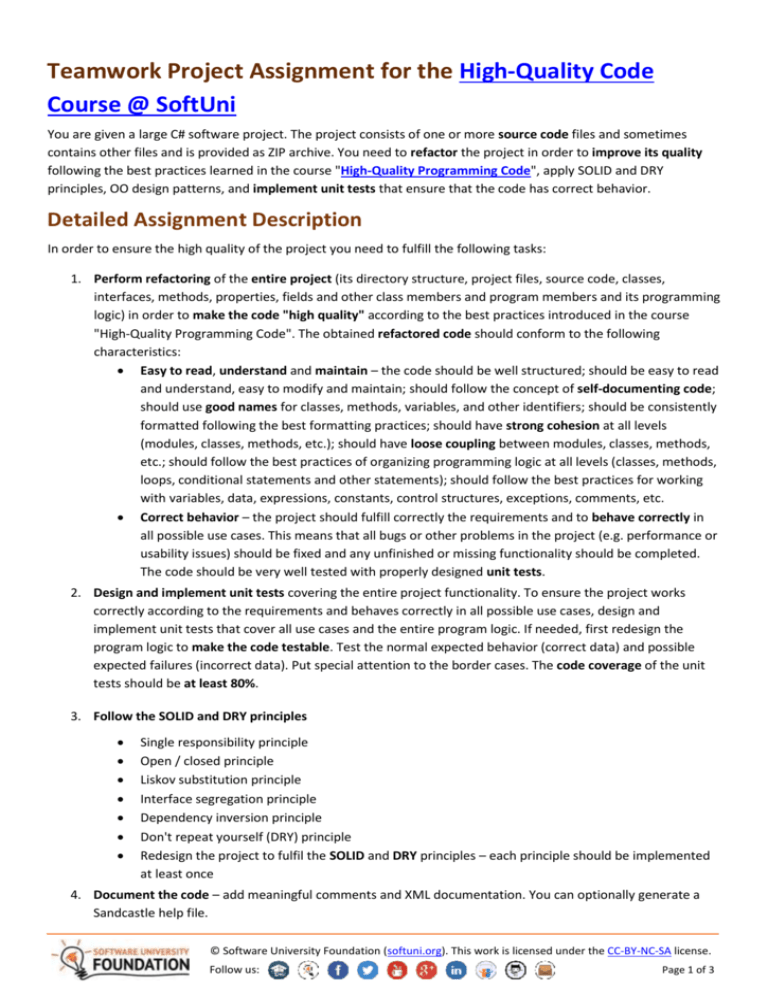
Teamwork Project Assignment for the High-Quality Code
Course @ SoftUni
You are given a large C# software project. The project consists of one or more source code files and sometimes
contains other files and is provided as ZIP archive. You need to refactor the project in order to improve its quality
following the best practices learned in the course "High-Quality Programming Code", apply SOLID and DRY
principles, OO design patterns, and implement unit tests that ensure that the code has correct behavior.
Detailed Assignment Description
In order to ensure the high quality of the project you need to fulfill the following tasks:
1. Perform refactoring of the entire project (its directory structure, project files, source code, classes,
interfaces, methods, properties, fields and other class members and program members and its programming
logic) in order to make the code "high quality" according to the best practices introduced in the course
"High-Quality Programming Code". The obtained refactored code should conform to the following
characteristics:
Easy to read, understand and maintain – the code should be well structured; should be easy to read
and understand, easy to modify and maintain; should follow the concept of self-documenting code;
should use good names for classes, methods, variables, and other identifiers; should be consistently
formatted following the best formatting practices; should have strong cohesion at all levels
(modules, classes, methods, etc.); should have loose coupling between modules, classes, methods,
etc.; should follow the best practices of organizing programming logic at all levels (classes, methods,
loops, conditional statements and other statements); should follow the best practices for working
with variables, data, expressions, constants, control structures, exceptions, comments, etc.
Correct behavior – the project should fulfill correctly the requirements and to behave correctly in
all possible use cases. This means that all bugs or other problems in the project (e.g. performance or
usability issues) should be fixed and any unfinished or missing functionality should be completed.
The code should be very well tested with properly designed unit tests.
2. Design and implement unit tests covering the entire project functionality. To ensure the project works
correctly according to the requirements and behaves correctly in all possible use cases, design and
implement unit tests that cover all use cases and the entire program logic. If needed, first redesign the
program logic to make the code testable. Test the normal expected behavior (correct data) and possible
expected failures (incorrect data). Put special attention to the border cases. The code coverage of the unit
tests should be at least 80%.
3. Follow the SOLID and DRY principles
Single responsibility principle
Open / closed principle
Liskov substitution principle
Interface segregation principle
Dependency inversion principle
Don't repeat yourself (DRY) principle
Redesign the project to fulfil the SOLID and DRY principles – each principle should be implemented
at least once
4. Document the code – add meaningful comments and XML documentation. You can optionally generate a
Sandcastle help file.
© Software University Foundation (softuni.org). This work is licensed under the CC-BY-NC-SA license.
Follow us:
Page 1 of 3
5. Briefly document the refactorings you have performed in order to improve the quality of the project. Use
English or Bulgarian language and follow the sample (see below).
Deliverables
1.
2.
3.
4.
The original source code (project files, .cs files) without executables.
The refactored source code (project files, .cs files) without executables.
The unit tests – source code (project files, .cs files) without executables.
The refactoring documentation.
Pack the project deliverables in a single ZIP archive. Be sure to avoid including large unused files in the archives
(e.g. compilation binaries and well-known libraries). Your archive should be up to 8 MB. Each team member should
submit the same archive as a homework.
Teamwork Guidelines
Use GitHub (http://github.com) as project hosting, source control and team collaboration environment.
Each team member should have commits in at least 3 different days.
Public Project Defense
Each team will have to deliver a public defense of its work in front of the other students, trainers and assistants.
Teams will have only 10 minutes for the following:
Demonstrate the refactored code (very shortly).
Explain what refactoring has been performed and why. The documentation will definitely help you.
Demonstrate the unit tests and code coverage.
Show the source code and explain how it works.
Explain how each team member has contributed: display the change logs in GitHub.
Optionally you might prepare a presentation (3-4 slides).
Please be strict in timing! On the 10th minute you will be interrupted! It is good idea to leave the last 2 minutes for
questions from the other students, trainers and assistants.
Be well prepared for presenting maximum of your work for minimum time. Bring your own laptop. Test it
preliminary with the multimedia projector. Open the project assets beforehand to save time.
Assessment Criteria
Refactored code quality (easy to read, understand and maintain, well-structured code, split into loosely
coupled methods / classes / files, correctly used OOP, with good naming, formatting, etc.) – 0…10
Correctly applied SOLID and DRY principles – 0…5
Unit tests (code made testable, well written unit tests, 80% code coverage or more) – 0…8
(including 2 points for code coverage)
Correct behavior (working project according to the problem description) – 0…5
Design patterns* (2 design patterns implemented) – 0…4
Code documentation (documented code, XML comments) – 0…5
Teamwork* (GitHub used; used GitHub issues; distribution of tasks) – 0…3
Bonus – 0…5
* If not all team members have contributed to the project, this does not affect the Teamwork points.
© Software University Foundation (softuni.org). This work is licensed under the CC-BY-NC-SA license.
Follow us:
Page 2 of 3
Give Feedback about Your Teammates
You will be invited to provide feedback about all your teammates, their attitude to this project, their technical skills,
their team working skills, their contribution to the project, etc. The feedback is important part of the project
evaluation so take it seriously and be honest.
Sample Refactoring Documentation for Project "Game 15"
1. Redesigned the project structure:
Renamed the project to Game-15.
Renamed the main class Program to GameFifteen.
Extracted each class in a separate file with a good name: GameFifteen.cs, Board.cs, Point.cs.
…
2. Reformatted the source code:
Removed all unneeded empty lines, e.g. in the method PlayGame().
Inserted empty lines between the methods.
Split the lines containing several statements into several simple lines, e.g.:
if (input[i] != ' ') break;
➔
if (input[i] != ' ')
{
break;
}
Formatted the curly braces { and } according to the best practices for the C# language
Put { and } after all conditionals and loops (when missing).
Character casing: variables and fields made camelCase; types and methods made PascalCase
Formatted all other elements of the source code according to the best practices introduced in
the course "High-Quality Programming Code".
…
3. Renamed variables:
4.
5.
6.
7.
8.
In class Fifteen: number ➔ numberOfMoves.
In Main(string[] args): g ➔ gameFifteen.
Introduced constants:
GameBoardSize = 4
ScoreBoardSize = 5
Extracted the method GenerateRandomGame() from the method Main().
Introduced class ScoreBoard and moved all related functionality in it.
Moved method GenerateRandomNumber(int start, int end) to separate class RandomUtils.
…
© Software University Foundation (softuni.org). This work is licensed under the CC-BY-NC-SA license.
Follow us:
Page 3 of 3
